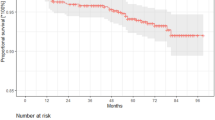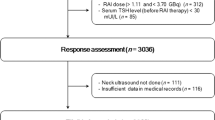Abstract
Purpose
To investigate the clinical importance of serum thyroglobulin (Tg) levels just before high-dose I-131 ablation therapy (preablation Tg) for predicting therapeutic failure in patients with papillary thyroid carcinoma (PTC).
Methods
Patients with PTC (n = 132) undergoing total thyroidectomy followed by the first high-dose I-131 ablation therapy (HI-Rx) were included in this retrospective review. Just before HI-Rx, preablation Tg, anti-Tg antibody, and TSH were measured. The patients were followed up for a mean period of 7 months (range 6–23 months) by I-123 whole-body scans (f/u IWBS) and stimulated Tg (f/u Tg). Therapeutic failure was defined by positive f/u IWBS or f/u Tg >2 ng/ml. We classified patients into three groups according to the value of preablation Tg (group 1, <1 ng/ml; group 2, ≥1 and <10 ng/ml; group 3, ≥10 ng/ml) and compared clinical variables to therapeutic response.
Results
Therapeutic failure was noted in 39 patients (29.5 %). On univariate analysis, T stage, tumor size, and preablation Tg were the statistically significant factors that could predict therapeutic failure. After multivariate analysis, preablation Tg was the only independent predictor of therapeutic failure (P < 0.001). The therapeutic failure rate was significantly increased as the preablation Tg level increased (11.3 %, 33.3 %, and 87.5 % in groups 1, 2, and 3, respectively; P < 0.001). Individuals with preablation Tg levels ≥10 ng/ml had 25.5 times greater chance of therapeutic failure than those with levels <10 ng/ml (95 % CI = 5.43–119.60; P < 0.001).
Conclusions
A high preablation Tg level is the most significant predictor of therapeutic failure at the time of first HI-Rx in patients with PTC.

Similar content being viewed by others
References
Pacini F, Schlumberger M, Harmer C, Berg GG, Cohen O, Duntas L, et al. Post-surgical use of radioiodine (131I) in patients with papillary and follicular thyroid cancer and the issue of remnant ablation: a consensus report. Eur J Endocrinol. 2005;153:651–9.
Cooper DS, Doherty GM, Haugen BR, Kloos RT, Lee SL, Mandel SJ, et al. Revised American Thyroid Association management guidelines for patients with thyroid nodules and differentiated thyroid cancer: The American Thyroid Association (ATA) guidelines taskforce on thyroid nodules and differentiated thyroid cancer. Thyroid. 2009;19:1167–214.
DeGroot LJ, Kaplan EL, McCormick M, Straus FH. Natural history, treatment, and course of papillary thyroid carcinoma. J Clin Endocrinol Metab. 1990;71:414–24.
Mazzaferri EL, Jhiang SM. Long-term impact of initial surgical and medical therapy on papillary and follicular thyroid cancer. Am J Med. 1994;97:418–28.
Freitas JE, Gross MD, Ripley S, Shapiro B. Radionuclide diagnosis and therapy of thyroid cancer: current status report. Semin Nucl Med. 1985;15:106–31.
Lim I, Kim SK, Hwang SS, Kim SW, Chung KW, Kang HS, et al. Prognostic implication of thyroglobulin and quantified whole body scan after initial radioiodine therapy on early prediction of ablation and clinical response for the patients with differentiated thyroid cancer. Ann Nucl Med. 2012;26:777–86.
Kendler DB, Vaisman F, Corbo R, Martins R, Vaisman M. Preablation stimulated thyroglobulin is a good predictor of successful ablation in patients with differentiated thyroid cancer. Clin Nucl Med. 2012;37:545–9.
Lee HJ, Rha SY, Jo YS, Kim SM, Ku BJ, Shong M, et al. Predictive value of the preablation serum thyroglobulin level after thyroidectomy is combined with postablation 131I whole body scintigraphy for successful ablation in patients with differentiated thyroid carcinoma. Am J Clin Oncol. 2007;30:63–8.
Kim TY, Kim WB, Kim ES, Ryu JS, Yeo JS, Kim SC, et al. Serum thyroglobulin levels at the time of 131I remnant ablation just after thyroidectomy are useful for early prediction of clinical recurrence in low-risk patients with differentiated thyroid carcinoma. J Clin Endocrinol Metab. 2005;90:1440–5.
Verburg FA, de Keizer B, Lips CJ, Zelissen PM, de Klerk JM. Prognostic significance of successful ablation with radioiodine of differentiated thyroid cancer patients. Eur J Endocrinol. 2005;152:33–7.
Mazzaferri EL, Kloos RT. Using recombinant human TSH in the management of well-differentiated thyroid cancer: current strategies and future directions. Thyroid. 2000;10:767–78.
Mazzaferri EL, Kloos RT. Is diagnostic iodine-131 scanning with recombinant human TSH useful in the follow-up of differentiated thyroid cancer after thyroid ablation? J Clin Endocrinol Metab. 2002;87:1490–8.
Schlumberger MJ. Papillary and follicular thyroid carcinoma. N Engl J Med. 1998;338:297–306.
Mazzaferri E, Robbins R, Spencer C, Braverman L, Pacini F, Wartofsky L, et al. A consensus report of the role of serum thyroglobulin as a monitoring method for low-risk patients with papillary thyroid carcinoma. J Clin Endocrinol Metab. 2003;88:1433–41.
Cailleux A, Baudin E, Travagli J, Ricard M, Schlumberger M. Is diagnostic iodine-131 scanning useful after total thyroid ablation for differentiated thyroid cancer? J Clin Endocrinol Metab. 2000;85:175–8.
Ronga G, Filesi M, Ventroni G, Vestri AR, Signore A. Value of the first serum thyroglobulin level after total thyroidectomy for the diagnosis of metastases from differentiated thyroid carcinoma. Eur J Nucl Med. 1999;26:1448–52.
Toubeau M, Touzery C, Arveux P, Chaplain G, Vaillant G, Berriolo A, et al. Predictive value for disease progression of serum thyroglobulin levels measured in the postoperative period and after 131I ablation therapy in patients with differentiated thyroid cancer. J Nucl Med. 2004;45:988–94.
Lin JD, Huang MJ, Hsu BRS, Chao TC, Hsueh C, Liu FH, et al. Significance of postoperative serum thyroglobulin levels in patients with papillary and follicular thyroid carcinomas. J Surg Oncol. 2002;80:45–51.
Ruiz-Garcia J, Ruiz AJ, Olea N, Pedraza V. Thyroglobulin level as a predictive factor of tumoral recurrence in differentiated thyroid cancer. J Nucl Med. 1991;32:395–8.
Hall FT, Beasley NJ, Eski SJ, Witterick IJ, Walfish PG, Freeman JL. Predictive value of serum thyroglobulin after surgery for thyroid carcinoma. Laryngoscope. 2003;113:77–81.
Chung JK, Park Y, Kim T, So Y, Kim SK, Park D, et al. Clinical significance of elevated level of serum antithyroglobulin antibody in patients with differentiated thyroid cancer after thyroid ablation. Clin Endocrinol. 2002;57:215–21.
Byun BH, Kwon SY, Chong AR, Kim JH, Yoo SW, Min JJ, et al. Both F-18 FDG-avidity and malignant shape of cervical lymph nodes on PET/CT after total thyroidectomy predict resistance to high-dose I-131 therapy in patients with papillary thyroid cancer. Asia Oceania J Nucl Med Biol. 2013;1:6–13.
Lin YS, Li TJ, Liang J, Li XY, Qiu LH, Wang SS, et al. Predictive value of preablation stimulated thyroglobulin and thyroglobulin/thyroid-stimulating hormone ratio in differentiated thyroid cancer. Clin Nucl Med. 2011;36:1102–5.
de Rosario PW, Guimaraes VC, Maia FF, Fagundes TA, Purisch S, Padrao EL, et al. Thyroglobulin before ablation and correlation with posttreatment scanning. Laryngoscope. 2005;115:264–7.
Webb RC, Howard RS, Stojadinovic A, Gaitonde DY, Wallace MK, Ahmed J, et al. The utility of serum thyroglobulin measurement at the time of remnant ablation for predicting disease-free status in patients with differentiated thyroid cancer: a meta-analysis involving 3947 patients. J Clin Endocrinol Metab. 2012;97:2754–63.
Sohns CY, Oh JJ. Dietary iodine intake and urinary iodine excretion in normal Korean adults. Yonsei Med J. 1998;39:355–62.
Lee HS, Min HS. Iodine intake and tolerable upper intake level of iodine for Koreans. Korean J Nutr. 2011;44:82–91.
Choi JH, Kim HI, Park JW, Song EH, Ko BJ, Cheon GJ, et al. Analysis of urine iodine excretion decrease by two-week stringent low iodine diet for remnant thyroid ablation with radioactive iodine in Korean patients with thyroid cancer; prospective study. Nucl Med Mol Imaging. 2008;42:375–82.
Dobrenic M, Huic D, Zuvic M, Grosev D, Petrovic R, Samardzic T. Usefulness of low iodine diet in managing patients with differentiated thyroid cancer—initial results. Radiol Oncol. 2011;45:189–95.
Pluijmen MJ, Eustatia-Rutten C, Goslings BM, Stokkel MP, Arias AM, Diamant M, et al. Effects of low-iodide diet on postsurgical radioiodide ablation therapy in patients with differentiated thyroid carcinoma. Clin Endocrinol. 2003;58:428–35.
Yoo IR, Kim SH, Seo YY, Oh JK, O. JH, Chung SK. The success rate of initial 131I ablation in differentiated thyroid cancer: comparison between less strict and very strict low iodine diets. Nucl Med. Mol Imaging. 2012;46:34–40.
Kim WG, Yoon JH, Kim WB, Kim TY, Kim EY, Kim JM, et al. Change of serum antithyroglobulin antibody levels is useful for prediction of clinical recurrence in thyroglobulin-negative patients with differentiated thyroid carcinoma. J Clin Endocrinol Metab. 2008;93:4683–9.
Tsushima Y, Miyauchi A, Ito Y, Kudo T, Masuoka H, Yabuta T, et al. Prognostic significance of changes in serum thyroglobulin antibody levels of pre- and post-total thyroidectomy in thyroglobulin antibody-positive papillary thyroid carcinoma patients. Endocr J. 2013;60:871–6.
Spencer CA, Takeuchi M, Kazarosyan M, Wang CC, Guttler RB, Singer PA, et al. Serum thyroglobulin autoantibodies: prevalence, influence on serum thyroglobulin measurement, and prognostic significance in patients with differentiated thyroid carcinoma. J Clin Endocrinol Metab. 1998;83:1121–7.
Verburg FA, Luster M, Cupini C, Chiovato L, Duntas LH, Elisei R, et al. Implications of thyroglobulin antibody positivity in patients with differentiated thyroid cancer: a clinical position paper. Thyroid. 2013;23:1190–2.
Hackshaw A, Harmer C, Mallick U, Haq M, Franklyn JA. 131I activity for remnant ablation in patients with differentiated thyroid cancer: a systematic review. J Clin Endocrinol Metab. 2007;92:28–38.
Pacini F, Capezzone M, Elisei R, Ceccarelli C, Taddei D, Pinchera A. Diagnostic 131-iodine whole-body scan may be avoided in thyroid cancer patients who have undetectable stimulated serum Tg levels after initial treatment. J Clin Endocrinol Metab. 2002;87:1499–501.
Sawka AM, Orlov S, Gelberg J, Stork B, Dowar M, Shaytzag M, et al. Prognostic value of postsurgical stimulated thyroglobulin levels after initial radioactive iodine therapy in well-differentiated thyroid carcinoma. Head Neck. 2008;30:693–700.
Conflict of Interest
Hee Jeong Park, Geum-Cheol Jeong, Seong Young Kwon, Jung-Joon Min, Hee-Seung Bom, Ki Seong Park, Sang-Geon Cho, Sae-Ryung Kang, Jahae Kim, Ho-Chun Song, Ari Chong, and Su Woong Yoo declare that they have no conflict of interest.
Ethics Statement
This study protocol was approved by the ethics committee at our hospital and was performed in accordance with the ethical standards laid down in the 1964 Declaration of Helsinki and its later amendments.
Author information
Authors and Affiliations
Corresponding author
Rights and permissions
About this article
Cite this article
Park, H.J., Jeong, GC., Kwon, S.Y. et al. Stimulated Serum Thyroglobulin Level at the Time of First Dose of Radioactive Iodine Therapy Is the Most Predictive Factor for Therapeutic Failure in Patients With Papillary Thyroid Carcinoma. Nucl Med Mol Imaging 48, 255–261 (2014). https://doi.org/10.1007/s13139-014-0282-4
Received:
Revised:
Accepted:
Published:
Issue Date:
DOI: https://doi.org/10.1007/s13139-014-0282-4




